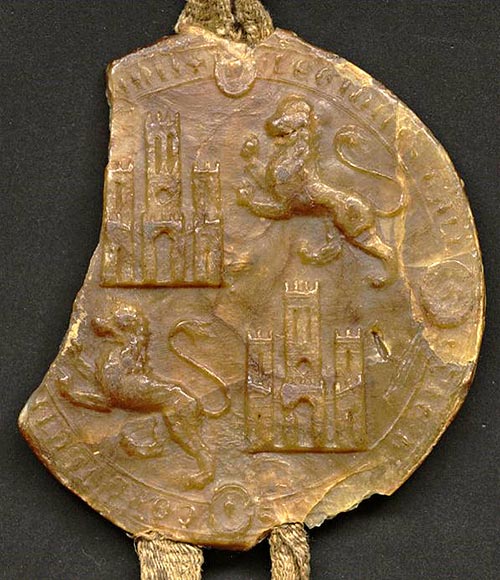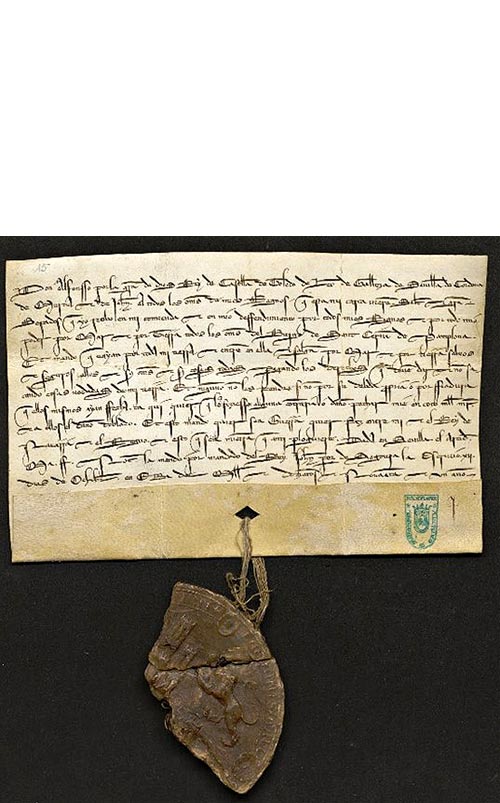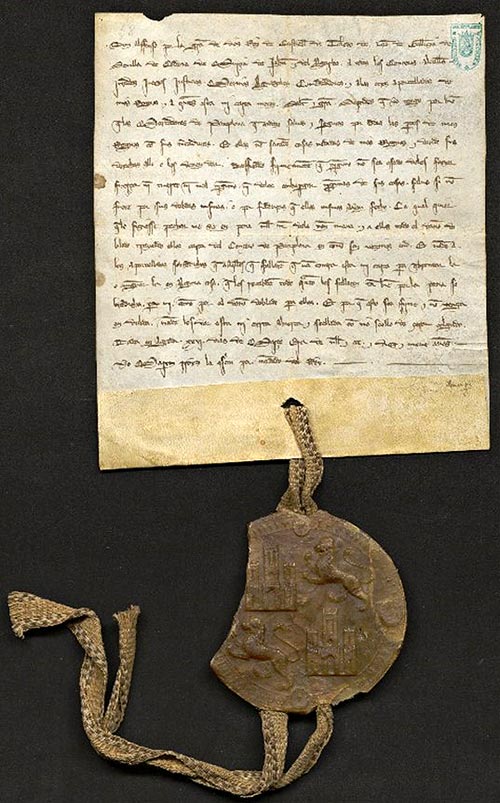The piece of the month of May 2024
STAMPS OF KING ALFONSO X WISE ON THE
MUNICIPALfile OF PAMPLONA
Ana Hueso Perez
AMP
Among the preparatory projects for the commemoration of the VI Centenary of the promulgation of the Privilege of the Union by King Charles III of Navarre in 1423, in 2023 the file Municipal of Pamplona began the reorganization of the so-called "Parchment Collection", a factitious series that groups the documents that are kept according to their support, the parchment, dated between 1129 and 1512. In this first phase, the documentary units that make up the collection were cleaned, reinstalled in conservation boxes and digitized.
The collection has descriptive tools developed at the time by historians and paleographers that make access to it possible, but the description of the documents, as well as their numerous seals or validation elements in accordance with current archival standards in order to make possible the programs of study of a global and comparative nature, is a pending task.
As wax seals are a subject of objects traditionally little studied from the perspective of art history and because of their absence in the known repertoires, both printed and digital, we thought it appropriate to make known the existence of two wax seals from the circular matrix of the "great seal", also known as "the cameos", with a diameter of 110 mm, pending from two documents of King Alfonso X Wise, as a contribution to the corpus of waxy seals issued from the chancellery of King Spanish and to the current knowledge the construction and reproduction of his image.
In 1253, the merchants of the Burgo de San Cernin, with the prior agreement of Theobald II, asked Alfonso X Wise of Castile for the use of the port of San Sebastian to obtain free transit by land and sea within their kingdoms for the exercise of trade, since they could not use the port of Bayonne as a result of the armed conflict of 1242 in which Theobald I made his entrance in Guyana. Sometimes it would be the merchants of Navarre themselves, other times the council of San Sebastian itself, who would approach the kings of Castile so that the Navarrese could trade with Flanders through the ports of Gipuzkoa, generating the corresponding documents for almost two centuries, in the confirmations made by the Castilian kings from Sancho IV (1286), Fernando IV (1301), Alfonso XI (1329), Pedro I (1351), Enrique II (1376), Juan I (1379), Enrique III (1393 and 1401), until Juan II (1409, 1433 and 1434), all of them conserved in the Municipal file of Pamplona.
Typologically they are two open letters, in Castilian language . In the first, given in Seville on October 12, 1253, Alfonso X Castile allowed the inhabitants of the Burgo de San Cernin de Pamplona free transit by sea and land within his kingdoms, provided they paid the established fees . A fragment corresponding to the upper half of the imprint in natural wax hangs from it by means of hemp threads (Fig. 1). In the second, dated in Agreda on March 26, 1281, the monarch orders his officials not to use force against the merchants of Pamplona who circulate in his kingdom. It preserves the seal almost in its entirety, joined to the parchment by means of a tricolor woven ribbon in shades of tan and white (Fig. 2).
|
|
|
|
(Fig. 1)1253 (235 x mm + 32 mm stem) (AMP_R020_015A) |
(Fig. 2) 1281 (210 x + sheet of 43 (AMP_R072_058) |
Grouping the information provided on this seal in works published by specialists in sigillography1, the obverse (Fig. 3), Mediterranean equestrian, sample the monarch with helmet and crown embracing a large shield of curved top, quartered with the territorial emblems, which also exhibits in its rich cuirass the horse, galloping to the left side, whose legs cut the legend and in the right hand the naked sword of wide, short and fluted blade. The reverse shows the counter-quartered castles and lions, also rampant, without crown (Fig. 4). The legend, in capital and lowercase, develops, as in the royal inscription, all the dominions of the Crown:
+:*S(igillvm): ALFONSI: D(e)I: GR*RACIA:REGI*S: CASTELLE*: ET: TOLETI, which continues on the reverse,+*: LEGIONIS: GALL*ECIE: HYSPALIS*: CORDVBE: MVRC*IE: ET: GIENNII.
Its uniqueness is evident in the ornamentation of cameos that divide the border into four sectors, on both sides. The themes of the cameos have been identified with animals, effigy motifs, mythological and astrological themes: a sea horse, two centaurs, a boar and a female bust, on the obverse; a bust, a seated figure, the head of Medusa and the sign of Scorpion, on the reverse, with reasonable margins of doubt due to their small size and the natural wear of the impressions.

(Fig. 3)

(Fig. 4)
The use of inlays, either alone as counterstamps or set in the matrix, seems to have been introduced in Spain by the Theobalds and was soon incorporated into their sigillary image by the Archbishop of Toledo, a son of James I and Alfonso X Wise2. However, the reuse of cameos and similar pieces was also a common internship in late antique and medieval goldsmithing. Alfonso X s own will X in Seville on January 24, 1284, reports the existence of crowns with cameos: "and the crowns with the stones and the cameos... that anyone who rightfully inherits our major lordship of Castile and Leon may have them".
1 MENÉNDEZ PIDAL, J. (1918). Spanish stamps of the Age average. file National Historical. Madrid: Tip. de la Revista de Archivos Bibliotecas y Museos (n.º 17). Gives references to the publications of the stamp since 1726.
GUGLIERI NAVARRO, A. (1974). Catalog Of stamps of the Sigillography Section of the National Historical file . I. Royal stamps. Madrid. Publishing Services del Ministerio de Education y Ciencia. (n.º 88).
2 The great wax seal of Alfonso X the tradition inherited from his father and brings it to its iconographic and aesthetic culmination.
SOURCES AND BIBLIOGRAPHY
file GENERAL OF NAVARRA. (AGN_CO_Documentos, Caj.3, n.3) Another copy is preserved, very deteriorated, from 1256, which hangs from a Life Donation Charter of Alfonso X Wise in favor of Teobaldo II of the towns of San Sebastián and Fuenterrabía in compliance with the sworn agreement between them.
file PAMPLONA MUNICIPAL COLLECTION OF PAMPLONA (AMP_R020_015A) and (AMP_R072_058)
BANGO TORVISO, I., "La llamada corona de Sancho IV y los emblemas de poder real", Alcanate: Revista de programs of study alfonsíes, 9 (2015), pp. 261-283.
CARRASCO LAZARENO, M. T., "Tipos y usos de sellado en la legislación y en la internship documental (siglos XII-XVII)", in Nicolás Ávila Seoane and Bárbara Santiago Medina (eds.), De sellos y blasones: miscelánea científica, Madrid, Universidad Complutense de Madrid, 2012, pp. 63-170.
CIERVIDE, R. and RAMOS, E. (1998). Medieval documentation of the file Municipal of Pamplona (1129-1356).. I. Donostia, Eusko Ikaskuntza, 1998 (Fuentes documentales del País Vasco, 84). (source 2)
GUGLIERI NAVARRO, A., Catalog of stamps of the Sigillography Section of the National Historical file . I. Royal stamps. Madrid. Publishing Services del Ministerio de Education y Ciencia, 1974, n.º 88.
MENÉNDEZ PIDAL, J., Spanish Stamps of the Spanish Age averageMadrid, file Histórico Nacional, Tip. de la Revista de Archivos Bibliotecas y Museos, n.º 17 (1918). Gives references to the publications of the stamp since 1726.
MENÉNDEZ PIDAL DE NAVASCUÉS, F., "Sellos, signos y emblemas de los reyes de Navarra, desde el Restaurador a los Teobaldos", Revista Príncipe de Viana, 241 (2007), p. 563.
TEIJEIRA PABLOS, M. D., "Creating an imprint, creating an image. Sellos y representación de Gonzalo de Aguilar, Arzobispo de Toledo (ca. 1300-1353)", Quintana: revista do department de Historia da Arte, 23 (2024).


